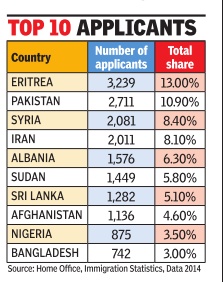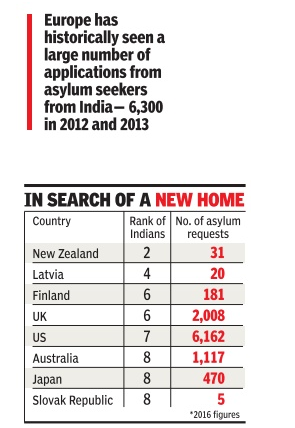Asylum seekers from South Asia
This is a collection of articles archived for the excellence of their content. Readers will be able to edit existing articles and post new articles directly |
Asylum seekers from South Asia
‘13k Indians applied for asylum in the last 2 years’
Kounteya Sinha TNN
London: Nearly 13,000 Indians applied for asylum in 44 industrialized countries in the last two years, figuring among the top asylum seekers in countries like Australia, Cyprus, Lithuania and Japan.
The United Nations Refugee Agency’s latest Asylum Trends 2013 report said 6,12,700 people applied for asylum in North America, Europe, East Asia and the Pacific last year —the highest total for any year since 2001.
According to the latest data, 6998 Indians applied for asylum in 2012 — the number dipping by 16% to 5872 in 2013. India was ranked 18th among asylum applications in 2012, it dropped to 26th the following year. Europe was the top destination for Indian asylumseekers —6300 applications in 2012 and 2013.
As many as 1393 Indians wanted asylum in Canada and US while 1162 wanted Australia and New Zealand. Around 165 applied for asylum in South Korea.
In comparison the number of Pakistani asylum-seekers increased from 23,640 to 26310 between 2012 and 2013. Bangladesh too saw a 47% increase in asylum-seekers – 6583 in 2012 to 9659 in 2013.
U.K. and South Asian asylum seekers in 2014
The Times of India, Sep 05 2015

Kounteya Sinha
Pakistanis among top asylum-seekers to Britain in 2014
Four of India's immediate neighbours -Pakistan, Bangladesh, Afghanistan and Sri Lanka -have emerged as the top applicants for asylum to UK in 2014. Pakistan was on top with 2,711 applicants followed by 1,282 from Sri Lanka, 1,136 from Afghanistan and nearly 800 from Bangladesh. Eritrea with 3,239 applications was the top applicant for asylum to UK in 2014. The other countries in the list were Iran with 2,011 applications, Albania (1,576), Sudan (1,449) and Nigeria (875). The Home Office immigration stats revealed by the Oxford Migration Observatory shows that men made up nearly (73%) main applicants for asylum in 2014.Eurostat data for top five European countries and UK in terms of 2014 asylum applications shows that the highest numbers of claims were seen in Germany (202,815), Sweden (81,325) and Italy (64,625).
2016: Indian, Pakistani asylum seekers
Meera Vankipuram|Indians among top asylum-seekers|Jul 18 2017: The Times of India (Delhi)
Indian diaspora grows steady and strong with India topping the list among countries whose citizens acquire foreign nationality , said a recent global study on migration. Unknown to many ,a tiny bit of this migration is driven by asylum-seekers from home who count among the biggest groups seeking refuge from “persecution“ in countries as far-flung as New Zealand (NZ) and Latvia. According to the International Migration Outlook 2017 report on OECD member-nations, top asylum-seekers to NZ between 2012 and 2016 were from China, India, Fiji and Iraq. The country note for NZ says that in 2015-16, 340 people sought asylum in NZ. Among these, India and China were the largest source countries of asylum-seekers (11% and 9%), followed by Fiji (8%), Iraq (7%) and Pakistan (6%). Refugee status was granted in 110 cases (35%) in all.
India was also among the top countri es for asylum requests in 2016 for Australia, Finland, Japan, Latvia, Slovak Republic, UK and US, according to statistics.
Latvia, a small country in Europe with a population of 2 million, for instance, had 6,200 registered international students in 2015-16, of which the largest proportion was from India and Uzbekistan at 18% each. According to experts, Indians requesting asylum there were either students who wanted to outstay their visas or others who were intercepted trying to enter the country .
“In Latvia there were 20 applications for asylum, and there were 20 Indians caught trying to cross the border. They might be the same people,“ says Jonathan Chaloff, policy analyst, International Migration Division at OECD. Indians have sought asylum in more than 40 countries for several years now, reveals data from the office of the United Nations High Commissioner for Refugees. Europe has historically seen a large number of applications from Indian asylumseekers -6,300 in 2012 and 2013. The refugee crisis in Syria and Iraq, however, has changed the situation on the continent over the last couple of years.
Asylum applications from India despite a relatively calm political and economic situation are due to factors ranging from students overstaying on their visas, low skilled job seekers trying to stay put in a high wage market, to refugees seeking resettlement, said experts.
Asked if Indian students who overstay their visas could apply for asylum, Chaloff says, “Yes, because it delays deportation. They have a chance of staying. They are also able to extend their stay while they wait for their application to be processed, even if it's rejected.“
Gladston Xavier, head of the department of social work, Loyola College, who has worked with Sri Lankan refugees in India for several years, says number of applications for asylum may be high, but success rate may not be. “They have to prove threat to life because of race, religion, political belief, political affiliations or gender. If not, the Refugee Status Branch will turn down the request or keep the decision pending,“ he says.
Vidya Mahambare, associate professor, economics and finance, Great Lakes Institute of Management in Chennai, says, “Asylum seekers from India may not be in the highskilled category . They may not have been able to get into good universities abroad and this may be the only alternative. India is a labour surplus country . Some may be looking for lower-end jobs abroad,“ she added.
By and large though, Xavier says, “India is not a refugee producing state, we receive refugees“.
